Posted on January 24th, 2019 by Mary Lord
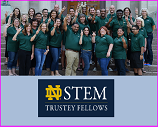 The Trustey Family STEM Teaching Fellows program at Notre Dame University provides top-tier professional development and continual feedback to teachers in grades 5 to 8 over the course of two years. The program, which covers travel, meals, and lodging for three summer institutes on campus and two winter summits, includes a $6,000 stipend. Apply by Feb. 28, 2019.
The Trustey Family STEM Teaching Fellows program at Notre Dame University provides top-tier professional development and continual feedback to teachers in grades 5 to 8 over the course of two years. The program, which covers travel, meals, and lodging for three summer institutes on campus and two winter summits, includes a $6,000 stipend. Apply by Feb. 28, 2019.
Read More
Filed under: For Teachers, K-12 Outreach Programs, Special Features | Comments Off on Trustey Family STEM Teaching Fellowship
Tags: Notre Dame University Center for STEM Education, Programs for Teachers, Resources for Teachers, STEM professional development for teachers, Teacher Training, Trustey Family STEM Teaching Fellows
Posted on January 11th, 2019 by Mary Lord
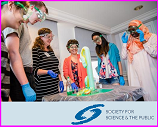 Science research competitions can spur confidence and open college doors, but many students – particularly those from underrepresented groups – don’t know about these opportunities. The Society for Science & the Public seeks to broaden participation through its Advocate Grant Program, which offers training, a $3,000 stipend, and paid trip to Washington, D.C., for individuals to help three to five underserved students navigate the transition from conducting to presenting their research at a competition. Apply by March 5, 2019.
Science research competitions can spur confidence and open college doors, but many students – particularly those from underrepresented groups – don’t know about these opportunities. The Society for Science & the Public seeks to broaden participation through its Advocate Grant Program, which offers training, a $3,000 stipend, and paid trip to Washington, D.C., for individuals to help three to five underserved students navigate the transition from conducting to presenting their research at a competition. Apply by March 5, 2019.
Read More
Filed under: For Teachers, K-12 Education News, K-12 Outreach Programs, Special Features | Comments Off on STEM Advocate Grant Program
Tags: Competitions for Students, Programs for Teachers, Science Fair, Society for Science & the Public, STEM Advocate Grant, STEM education, Teacher Training
Posted on January 11th, 2019 by Mary Lord
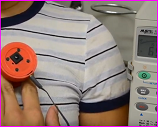 Health clinics in the developing world often are noisy places, making it doubly difficult for medics to hear whether a child has pneumonia or other potentially fatal respiratory illness. So engineers and doctors at Johns Hopkins University in Baltimore, Md., teamed up to reinvent the stethoscope using audio technology and artificial intelligence.
Health clinics in the developing world often are noisy places, making it doubly difficult for medics to hear whether a child has pneumonia or other potentially fatal respiratory illness. So engineers and doctors at Johns Hopkins University in Baltimore, Md., teamed up to reinvent the stethoscope using audio technology and artificial intelligence.
Read More
Filed under: Special Features | Comments Off on Engineering a “Smart” Stethoscope
Tags: artificial intelligence, Biomedical Engineering, Johns Hopkins University, public health, smart stethoscope
Posted on January 11th, 2019 by Mary Lord
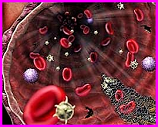 In this NGSS-aligned activity, high school students work as biomedical engineers to find liquid solutions that can clear away polyvinyl acetate polymer “blood clots” in model arteries made of clear, flexible tubing. Teams create samples of the “blood clot” polymer to discover the concentration of the model clot and then test a variety of liquids to determine which most effectively breaks it down. Students learn the importance of the testing phase in the engineering design process, because they are only given one chance to present the team’s solution and apply it to the model blood clot.
In this NGSS-aligned activity, high school students work as biomedical engineers to find liquid solutions that can clear away polyvinyl acetate polymer “blood clots” in model arteries made of clear, flexible tubing. Teams create samples of the “blood clot” polymer to discover the concentration of the model clot and then test a variety of liquids to determine which most effectively breaks it down. Students learn the importance of the testing phase in the engineering design process, because they are only given one chance to present the team’s solution and apply it to the model blood clot.
Read More
Filed under: Class Activities, Grades 9-12, Lesson Plans | Comments Off on Let the Blood Flow: Biomedical Artery Unclogging Experiment
Tags: arteries, Biomedical Engineering, Chemistry, circulatory system, Class Activities, Grades 9-12, heart, Lesson Plan, NGSS, stent, TeachEngineeirng, UCLA SEEK GK-12 program, valves
Posted on January 10th, 2019 by Mary Lord
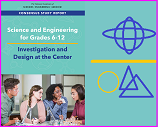 A major new consensus study from the National Academies of Sciences, Engineering, and Medicine, underscores the vital role of teachers in creating the hands-on, multidisciplinary STEM education for every student envisioned by the Next Generation Science Standards. The report also calls for more creation and sharing of free educational materials so teachers no longer have to spend hours each week searching for curriculum.
A major new consensus study from the National Academies of Sciences, Engineering, and Medicine, underscores the vital role of teachers in creating the hands-on, multidisciplinary STEM education for every student envisioned by the Next Generation Science Standards. The report also calls for more creation and sharing of free educational materials so teachers no longer have to spend hours each week searching for curriculum.
Read More
Filed under: For Teachers, Grades 6-8, Grades 9-12, K-12 Education News, Special Features | Comments Off on STEM Ed. Report: Teachers Key to Reform
Tags: Education Policy, Engineering Design, National Academies of Sciences, NGSS, Public Policy, Science and Engineering for Grades 6-12: Investigation and Design at the Center, STEM education, STEM equity
Posted on January 10th, 2019 by Mary Lord
 Spatial visualization – the ability to imagine objects from different angles – is a key STEM problem-solving skill that varies widely by gender, race, and cultural background. Yet it’s rarely taught. The University of Colorado-Boulder’s College of Engineering developed an inexpensive training program that closed STEM performance gaps so well it’s required of all incoming engineering students. The curriculum is now available for free online so any school can advance STEM equity.
Spatial visualization – the ability to imagine objects from different angles – is a key STEM problem-solving skill that varies widely by gender, race, and cultural background. Yet it’s rarely taught. The University of Colorado-Boulder’s College of Engineering developed an inexpensive training program that closed STEM performance gaps so well it’s required of all incoming engineering students. The curriculum is now available for free online so any school can advance STEM equity.
Read More
Filed under: K-12 Outreach Programs, Special Features, Web Resources | Comments Off on STEM Equity? Teach This Key Skill
Tags: 3-D modeling, ASEE Prism magazine, Curriculum, Design, Engineering Plus, Internet Resources, Jacob Segil, Outreach, Research on Learning, Resources for Teachers, spatial visualization training workshops, STEM education, STEM equity, Technology for Learning, University of Colorado Boulder College of Engineering, Web Resources
Posted on January 9th, 2019 by Mary Lord
 Middle school students address misconceptions and learn about thermal energy transfer while investigating the insulating properties of various materials. They then follow the engineering design process to create, test, and redesign a structure (igloo) to keep an ice cube (penguin) from melting.
Middle school students address misconceptions and learn about thermal energy transfer while investigating the insulating properties of various materials. They then follow the engineering design process to create, test, and redesign a structure (igloo) to keep an ice cube (penguin) from melting.
Read More
Filed under: Class Activities, Grades 6-8, Grades 9-12, Lesson Plans | Comments Off on Save the Penguins
Tags: arctic engineering, Class Activities, Curriculum, Energy, Environmental Engineering, Grades 6-8, Grades 9-12, habitat, heat transfer misconceptions, ice, insulation, Lesson Plan, NGSS aligned, Physics, polar ice, Save the Penguins
Posted on January 3rd, 2019 by Mary Lord
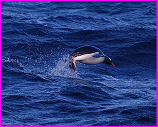 Middle and high school students learn about the importance of the polar regions by connecting with scientists and the data generated by their cutting-edge research on penguins and ocean environments.
Middle and high school students learn about the importance of the polar regions by connecting with scientists and the data generated by their cutting-edge research on penguins and ocean environments.
Read More
Filed under: Class Activities, Grades 6-8, Grades 9-12, Web Resources | Comments Off on Polar Ice
Tags: Class Activities, Climate Change, Environmental Engineering, Grades 6-8, Grades 9-12, Lesson Plan, Liesl Hotaling, Marine Science, NSTA, oceanography, penguins, polar ice, polar research, Resources for Teachers
Posted on January 2nd, 2019 by Mary Lord
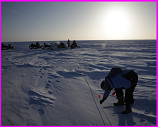 Geoengineer Leslie Field seeks to mitigate climate change by restoring ice in the Arctic. Her solution? Spread an environmentally safe silica sand in strategic locations to reflect heat “like a white shirt on a hot summer day” and protect the frozen water below.
Geoengineer Leslie Field seeks to mitigate climate change by restoring ice in the Arctic. Her solution? Spread an environmentally safe silica sand in strategic locations to reflect heat “like a white shirt on a hot summer day” and protect the frozen water below.
Read More
Filed under: Special Features | Comments Off on Arctic “Dust”
Tags: arctic ice, Climate Change, Environmental Engineering, Environmental science, geoengineering, global warming, Harvard Solar Geoengineering Research Program, ice911, Leslie Field, Public Policy, Web Resources, Women in Engineering
 The Trustey Family STEM Teaching Fellows program at Notre Dame University provides top-tier professional development and continual feedback to teachers in grades 5 to 8 over the course of two years. The program, which covers travel, meals, and lodging for three summer institutes on campus and two winter summits, includes a $6,000 stipend. Apply by Feb. 28, 2019.
The Trustey Family STEM Teaching Fellows program at Notre Dame University provides top-tier professional development and continual feedback to teachers in grades 5 to 8 over the course of two years. The program, which covers travel, meals, and lodging for three summer institutes on campus and two winter summits, includes a $6,000 stipend. Apply by Feb. 28, 2019.








 Science research competitions can spur confidence and open college doors, but many students – particularly those from underrepresented groups – don’t know about these opportunities. The Society for Science & the Public seeks to broaden participation through its Advocate Grant Program, which offers training, a $3,000 stipend, and paid trip to Washington, D.C., for individuals to help three to five underserved students navigate the transition from conducting to presenting their research at a competition. Apply by March 5, 2019.
Science research competitions can spur confidence and open college doors, but many students – particularly those from underrepresented groups – don’t know about these opportunities. The Society for Science & the Public seeks to broaden participation through its Advocate Grant Program, which offers training, a $3,000 stipend, and paid trip to Washington, D.C., for individuals to help three to five underserved students navigate the transition from conducting to presenting their research at a competition. Apply by March 5, 2019.  Health clinics in the developing world often are noisy places, making it doubly difficult for medics to hear whether a child has pneumonia or other potentially fatal respiratory illness. So engineers and doctors at Johns Hopkins University in Baltimore, Md., teamed up to reinvent the stethoscope using audio technology and artificial intelligence.
Health clinics in the developing world often are noisy places, making it doubly difficult for medics to hear whether a child has pneumonia or other potentially fatal respiratory illness. So engineers and doctors at Johns Hopkins University in Baltimore, Md., teamed up to reinvent the stethoscope using audio technology and artificial intelligence. In this NGSS-aligned activity, high school students work as biomedical engineers to find liquid solutions that can clear away polyvinyl acetate polymer “blood clots” in model arteries made of clear, flexible tubing. Teams create samples of the “blood clot” polymer to discover the concentration of the model clot and then test a variety of liquids to determine which most effectively breaks it down. Students learn the importance of the testing phase in the engineering design process, because they are only given one chance to present the team’s solution and apply it to the model blood clot.
In this NGSS-aligned activity, high school students work as biomedical engineers to find liquid solutions that can clear away polyvinyl acetate polymer “blood clots” in model arteries made of clear, flexible tubing. Teams create samples of the “blood clot” polymer to discover the concentration of the model clot and then test a variety of liquids to determine which most effectively breaks it down. Students learn the importance of the testing phase in the engineering design process, because they are only given one chance to present the team’s solution and apply it to the model blood clot. A major new consensus study from the National Academies of Sciences, Engineering, and Medicine, underscores the vital role of teachers in creating the hands-on, multidisciplinary STEM education for every student envisioned by the Next Generation Science Standards. The report also calls for more creation and sharing of free educational materials so teachers no longer have to spend hours each week searching for curriculum.
A major new consensus study from the National Academies of Sciences, Engineering, and Medicine, underscores the vital role of teachers in creating the hands-on, multidisciplinary STEM education for every student envisioned by the Next Generation Science Standards. The report also calls for more creation and sharing of free educational materials so teachers no longer have to spend hours each week searching for curriculum. Spatial visualization – the ability to imagine objects from different angles – is a key STEM problem-solving skill that varies widely by gender, race, and cultural background. Yet it’s rarely taught. The University of Colorado-Boulder’s College of Engineering developed an inexpensive training program that closed STEM performance gaps so well it’s required of all incoming engineering students. The curriculum is now available for free online so any school can advance STEM equity.
Spatial visualization – the ability to imagine objects from different angles – is a key STEM problem-solving skill that varies widely by gender, race, and cultural background. Yet it’s rarely taught. The University of Colorado-Boulder’s College of Engineering developed an inexpensive training program that closed STEM performance gaps so well it’s required of all incoming engineering students. The curriculum is now available for free online so any school can advance STEM equity.  Middle school students address misconceptions and learn about thermal energy transfer while investigating the insulating properties of various materials. They then follow the engineering design process to create, test, and redesign a structure (igloo) to keep an ice cube (penguin) from melting.
Middle school students address misconceptions and learn about thermal energy transfer while investigating the insulating properties of various materials. They then follow the engineering design process to create, test, and redesign a structure (igloo) to keep an ice cube (penguin) from melting.  Middle and high school students learn about the importance of the polar regions by connecting with scientists and the data generated by their cutting-edge research on penguins and ocean environments.
Middle and high school students learn about the importance of the polar regions by connecting with scientists and the data generated by their cutting-edge research on penguins and ocean environments. Geoengineer Leslie Field seeks to mitigate climate change by restoring ice in the Arctic. Her solution? Spread an environmentally safe silica sand in strategic locations to reflect heat “like a white shirt on a hot summer day” and protect the frozen water below.
Geoengineer Leslie Field seeks to mitigate climate change by restoring ice in the Arctic. Her solution? Spread an environmentally safe silica sand in strategic locations to reflect heat “like a white shirt on a hot summer day” and protect the frozen water below.